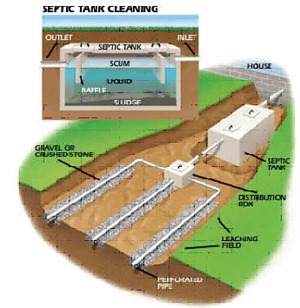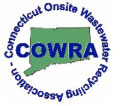|
A conventional septic system contains two major components-a holding tank and a leaching field. The tank allows anaerobic bacteria to act on the waste and break it down into liquid, sludge and scum. The sludge accumulates on the bottom of the tank. Then the scum floats on top of the liquid and the liquid flows out of the tank to the leaching field. There, it drains through perforated pipes into gravel-filled trenches. The liquid then percolates into the soil. If the sludge level gets too high, it will be transported by the liquid into the leaching field. The sludge will clog the pipe perforations, the air spaces between the gravel or crushed stone and even the air spaces between the soil particles below. Over time the clogged leaching field will become a soggy, odorous mess with lush grass growing over it. In severe instances, waste can back into the house and flow out plumbing fixtures on the house's lowest level. Therefore it is necessary for a house's septic tank be pumped to prevent solids from making their way out of the tank and into the leaching field or home.

Maybe this will help. The only way to keep the septic tank functioning properly, and avoid premature system failure is to have your septic tank pumped by Stepule's Sanitation Service, Inc. or a competent local cleaning service on at regular intervals. The frequency of cleanings will vary depending on usage, conditions; age of system, system size, and the like, nevertheless, the health department authorities, and the Environmental Protection Agency recommends that a system be pumped every one to two years. While the frequency may vary, every septic tank should be pumped every two to three years. Failure to maintain your system can allow more solids to pass into the drain field increasing the likely hood of a premature failure which means an expensive repair to you at least. It is only during a cleaning that an inspection of the tank and baffles can take place. If the baffles fail, or the tank develops a leak, a serious problem of which can accelerate a drain field deterioration, and ultimately a premature failure. These items are far less costly to repair than a drain field, and usually are quick to repair.
State of Connecticut, Department of Public Health
Dear Property Owner:
On January 1, 2000 a revision to the Public Health Code - Technical Standards began requiring that all existing septic tanks that exceed a depth of 12 inches below grade be retrofitted with risers at the time of tank cleaning.
The purpose of this revision is to make it easier to gain access to the septic tank for cleaning and inspection purposes. Having to dig down more than 12" into what in many cases is compact, stone filled material is both time consuming and costly, when this task has to be accomplished by the septic tank cleaning service. It is hoped that by facilitating tank access, more frequent tank cleanings will be scheduled in the future. Failure to pump out a septic tank every three to five years (depending on the use) could lead to excessive suspended solids leaving the tank into the leaching system. Over a period of time (months or years) this excessive material builds up on the leaching system's infiltrative surfaces causing increased blockage and a costly system failure. Therefore, more frequent cleanings are beneficial to the long term performance of the septic system.
Installing a riser is not a recommendation but a Public Health Code requirement. Contact your licensed septic tank cleaner or septic system installer for further information. If you would like to discuss this matter, please contact the Environmental Engineering Section of the Department of Public Health at (860) 509-7296.
|


